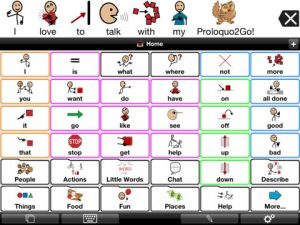Planning for a life-stage transition – Assessing where to begin
June 5, 2017Social skills learning and incorporating social choice
July 19, 2017Communication, generally speaking uses a combination of verbal and non-verbal behaviours to express or convey a message.
Speech is often used to get our message across to another person and can be supplemented using various non-verbal behaviours and gestures. Speech allows us to communicate our needs and wants ultimately resulting in those needs and wants being met.
However, on some occasions, speech can be inhibited or difficult to express when anxiety or stress is heightened. Often the difficulty lies in the processing of the incoming information (as well as external stimuli ie, sensory input, from the surrounding environment) and making sense of it all, which can lead to a breakdown in the translation of messages.
In this situation, the person should be provided with alternative choices of communication that will support their immediate needs and wants. Knowing and understanding the alternative methods of communication is crucial to assisting the person to communicate. Both the person needing to communicate and the support person/people should ideally have experience in using other forms of communication.
Other forms of communication as an alternative to speech include the augmentative and alternative communication systems. ‘Augmentative and alternative communication (AAC) includes all forms of communication (other than oral speech) that are used to express thoughts, needs, wants, and ideas.’ (More information found at http://www.asha.org/public/speech/disorders/AAC/)
Such systems as Picture Exchange Communication Systems (PECS), the use of signs and gestures (Auslan & Key Word Sign), speech generated devices and digital devices with applications such as Proloquo2go are just a few examples of alternative ways to communicate.


Picture Exchange Communication System Proloquo2go
As a support person, it is important to understand that whilst someone is experiencing over stimulation or overload, not to insist that they communicate there and then, but to allow them the space and time to calm for when they are ready to. Sometimes communicating by using a simple gesture such as a ‘thumbs up’ or a ‘thumbs down’ can indicate how a person might be feeling without the need to pry for more information.
Having an understanding and knowledge of how to use alternatives to spoken language, helps to support a person having difficulty using their words when feeling overwhelmed, still giving them the opportunity to be able to communicate their needs and wants.
Written by Sherri Cincotta

2 Comments
Hi Creating Connections team- thanks for alerting people to such an important topic. The link below takes you to an Australian Speech pathology link about this great topic.
http://www.speechpathologyaustralia.org.au/spaweb/Document_Management/Public/Fact_Sheets.aspx#anchor_aac
Cheers,
Ruth
Thanks so much Ruth! Lots of great information there!!